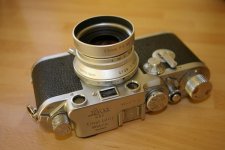Dralowid
Michael
Unfortunately such a conversion destroys the value of the original camera.
A 4 digit original Leica I is nowadays a very valuable camera, even with a fixed Elmar. Just look at the Westlicht auctions. I sold the cameras that I had under s/n 10,000 a few years ago and made a surprising amount of money.
Having said that a black conversion such as those above with a 'nice' number is on its way up the value ladder apace. Again see the Westlicht auctions.
From memory, in Michael's camera museum in Melbourne there is a very nice conversion of a three digit camera to a Leica III of some sort. Whatever it is it represents something of Holy Grail.
I don't chase serial numbers but sometimes I do come across a conversion that is wortha frction of the original.
Michael
A 4 digit original Leica I is nowadays a very valuable camera, even with a fixed Elmar. Just look at the Westlicht auctions. I sold the cameras that I had under s/n 10,000 a few years ago and made a surprising amount of money.
Having said that a black conversion such as those above with a 'nice' number is on its way up the value ladder apace. Again see the Westlicht auctions.
From memory, in Michael's camera museum in Melbourne there is a very nice conversion of a three digit camera to a Leica III of some sort. Whatever it is it represents something of Holy Grail.
I don't chase serial numbers but sometimes I do come across a conversion that is wortha frction of the original.
Michael



